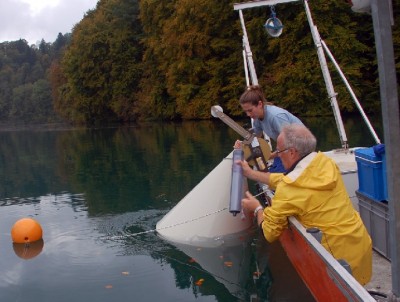Oct
19
There’s Methane Coming From Those Lakes
October 19, 2010 | 2 Comments
With no great surprise researchers at the Swiss Federal Institute of Aquatic Science and Technology found that substantial amounts of the greenhouse gas methane (natural gas) releases not only from large tropical reservoirs but also from run-of-the-river reservoirs in cool high mountainous Switzerland. Its been known that warm reservoirs with a supply of organic matter have microbes to digest the matter and release methane, but in Switzerland it came as a surprise.
When they first saw the data, environmental chemist Tonya Del Sontro and her PhD supervisor Professor Bernhard Wehrli were skeptical. But the unexpectedly high values stood up to careful analysis: On average, daily emissions of methane (CH4) from Lake Wohlen amount to more than 150 mg per m2 surface area. This is by far the highest emission rate recorded to date for a temperate reservoir. At a summer water temperature of 17°C the rate is twice as high, which makes it comparable to the emission rates observed for tropical reservoirs.
Overall, the Lake Wohlen reservoir on the river Aare produces 150 metric tons of methane a year. This is about the same amount as is emitted annually by around 2000 cows, which are for the global warming crowd a nemeses to the atmosphere. In more sensible terms 150 metric tons could be equivalent the CO2 emissions or fuel needs over 25 million cars kilometers or 15.5 million miles. Wohlen isn’t even that big of a lake.
This is worthwhile news. The careful observer knows that methane is an abundant naturally produced fuel, the sources of which are just getting explored. For the Swiss Institute’s researchers the funding might have come from the global warming scheme. Del Santos said, “So hydropower isn’t quite as climate-neutral as people have assumed in the past,” in a reference to hydropower dammed reservoirs. Little does she seem to know or the press release writer that one way or another the microbes are going to get that organic matter, dam or not.
At the same time, she does not wish to dramatize the findings of her research: even if the Aare river hydropower plant is taken to be responsible for all the methane emissions from the reservoir, and these are expressed in CO2-equivalents, a coal-fired power station with the same output produces 40 times as much CO2. However, the emissions from Lake Wohlen do indicate that run-of-the-river reservoirs can also be significant sources of methane emissions in temperate regions. As Professor Wehrli notes, “That’s something which has previously been overlooked in greenhouse gas budgets.” It’s a great resource if someone can catch the methane before is goes to the atmosphere. 150 metric tons equals 165 standard tons, about eight semi-truck trailer loads by weight. Keep in mind that a therm gained by methane vs coal gives off a lot less CO2, too.
The methane production in Lake Wohlen is attributable to organic matter transported by the Aare River from Lake Thun and the rest of the drainage basin. In the reservoir, the organic matter settles rapidly, undergoing microbial fermentation in the sediments. “In the summer,” says Del Sontro, “the water in Lake Wohlen sometimes looks like champagne, with masses of gas bubbles rising to the surface.” To study these bubbles, the Eawag scientists used custom-made gas traps in the form of inverted funnels. The analyses revealed that they were mainly composed of methane.
That might be an idea for a diversion to collect the run off and gather the organic matter for a process to make methane for use and retuning cleaner water to the river.
During the winter, due to the cold temperatures, methane emissions are minimal. According to Wehrli, this explains why climate researchers have previously focused largely on the huge reservoirs lying in tropical regions where, temperatures are warm throughout the year, and inundated forest areas provide a large supply of nutrients for microbes. Likewise, low water temperatures and low nutrient inputs mean that large Alpine reservoirs do not give rise to significant methane emissions. The researchers now plan to study other run-of-the-river reservoirs on the Central Plateau so as to determine whether Lake Wohlen is a special case, or whether methane budgets need to be revised for Switzerland as a whole.
Odds are that Lake Wohlen isn’t special other than the surprise value of high altitude and low temperature. But the research does beg certain questions. First would be the organic value of say the Mississippi River in Louisiana. The Mississippi is rich in organics and fertility and should be a stunningly large source of raw material. The second question could be is there an economical way to harvest the organics and process to methane products for sale. The third then would be what state in the drainage basin is going to let all that get to Louisiana when they realize what’s going on.
Sometimes the global warming folks just can’t help themselves. There are rare instances of the money spent revealing a new opportunity. This writer can’t help but smile over this one.
Del Sontro’s full paper is available here as a pdf download.
Comments
2 Comments so far




Resources like the one you mentioned here will be very useful to me! I will post a link to this page on my blog. I am sure my visitors will find that very useful.
i was skeptical with this news..